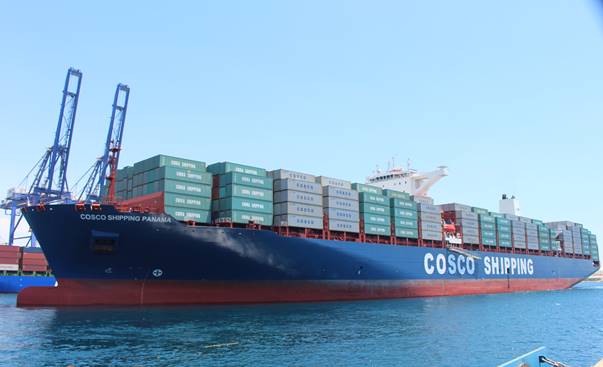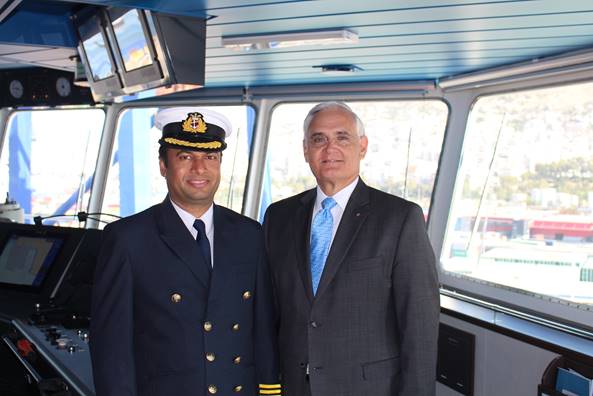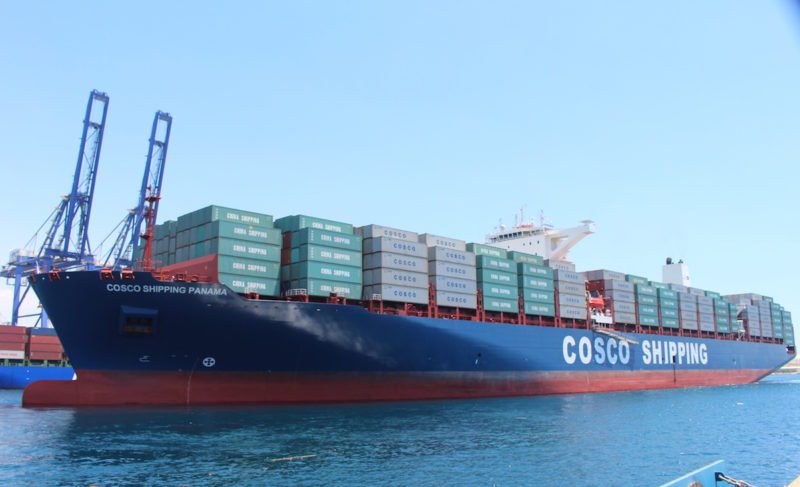Tell me that this is not one of the largest vessels you have seen. The COSCO is headed here to inaugurate the opening of the expanded Panama Canal and we are fortunate for the amount of rain that we have had recently.
Recent rain has helped the Panama Canal Authority lift draft restrictions for vessels after months of drought threatened to pose a long-term challenge for the canal authority, especially as it prepares to open up the waterway to bigger ships later this month.
Effective immediately, the maximum authorized draft for vessels transiting the existing Panamax locks is set to the standard max of 12.04 meters (39.5 feet) Tropical Fresh Water. Since April 18, the maximum draft had been restricted to 11.89 meters (39.0 feet).
The restrictions were caused by drought in the Panama Canal watershed caused by this year’s particularly strong El Niño, which forecasters declared over this week.
“The weather forecast for the remainder of the rainy season indicates that no further draft restrictions for the Panamax locks will be required,” the ACP said in an advisory to shipping earlier this week.
For the Panama Canal Authority, the rain is coming just in time.
Some wet weather towards the end of May allowed the ACP to suspend implementing a second and even third round of restrictions, which would have limited the allowable draft to just 11.59 meters (38.0 feet). Not to mention with the opening of the Panama Canal’s new locks later this month, more restrictions ultimately mean more problems for the ACP, shippers and industry stakeholders who have invested millions of dollars preparing for the expanded Panama Canal.
Even with the recent rain, as it stands now the maximum allowable draft for vessels transiting the new Neopanamax locks has been raised to 13.11 meters (43 feet) TFW, an improvement from the 12.8 meters (42 feet) set by the ACP in May but still more than two meters below the advertised 15.20 meter draft that the new locks were designed to accommodate.
Regardless of the weather, inauguration of the Panama Canal expansion has been set for June 26 with commercial operations kicking off the following day. In fact, the ship that is to make the inaugural transit, the containership COSCO Shipping Panama, has just set sail on a 14-day voyage from the Greek Port of Piraeus.
So all there is to do now is to wait and pray for rain. But luckily forecasters are now calling for an increased chance of La Niña in the second half of 2016, which is known for bringing cool and wet weather to the southern portion of Central America.
“The ACP continues to monitor the Gatun Lake level in order to further adjust the draft restrictions and will announce changes in a timely manner,” the ACP said.

Panama City, Panama – The container vessel COSCO Shipping Panama set sail from the Greek Port of Piraeus today on its way to Panama to make history. The Neopanamax vessel will make the inaugural transit of the Expanded Panama Canal on Sunday, June 26, after a 14-day journey.

“I am very excited to be here today to witness the sailing of the ship from Greece, but also meet the Captain and his crew,” said Administrator Quijano. “We are very pleased to be here watching it leave from Port of Piraeus. He is very thrilled to be part of this inaugural transit.”
“I had transited the Panama Canal many times before and it has been a great experience, but being the master of the first vessel to transit the expanded Canal is an experience of a century,” said Captain Rodrigues. “The Panama Canal is testament to the diligence and wisdom of the people of Panama. The Panama Canal Expansion is a major event on itself and a milestone in global history. I would like to congratulate the people of Panama for their efforts and contribution to global economy.”
Cosco Shipping Panama is a new vessel constructed and launched on January 2016. The Neopanamax containership is 299.98 meters in length and 48.25 meters in beam, and has a container carrying capacity of 9,472 TEUs. Originally named Andronikos, the vessel was renamed by China COSCO Shipping to pay respect to the people of Panama and for the honor of the inaugural transit. This ship was selected during a draw for the inaugural transit through the expanded waterway. Coincidentally, the ship was built in Hyundai Samho Heavy Industries Co., Ltd, the same company that constructed the valves that control the flow of water through the new locks of the Canal.
“Over a hundred years ago, the SS Ancon made history as the first vessel to transit the Panama Canal,” said Administrator Quijano. “In a few weeks, COSCO Shipping Panama, the Panama Canal, and the people of Panama will change the face of global shipping and international commerce. I am humbled and honored to lead the Panama Canal to this great milestone with the thousands who made this bold vision a reality.”
During the inauguration, COSCO Shipping Panama will transit Agua Clara Locks on the Atlantic side during the early morning and Cocoli Locks in the afternoon. The regular schedule of transits through the Expanded Canal will follow the next day, June 27.
The Panama Canal Expansion Program is the largest construction project undertaken in the waterway since its opening in 1914. Considered and analyzed for a decade with more than 100 studies, construction on the first-ever expansion began in 2007 to provide the world with greater shipping options, better maritime service, enhanced logistics and supply-chain reliability.
The project doubles the waterway’s cargo capacity, enhancing the Canal’s efficiency, reliability and customer service. Since Neopanamax vessels can now take advantage of the Canal’s vast benefits, new routes, liner services and other maritime changes are expected to emerge.
